Kyoto vs Osaka: Your Essential Guide to Japan's Contrasting Cities
Should you choose the elegant ancient capital or the vibrant metropolis? This is the choice many travelers face when visiting Japan.
I have lived in Osaka for over 10 years, and before that, I experienced life in Kyoto. Through these experiences, I've felt the essence of these two captivating cities firsthand.
My days in Kyoto were characterized by a quiet environment and a sense of changing seasons. As an ancient capital with over 1200 years of history, Kyoto's World Heritage temples and shrines like Kinkaku-ji and Kiyomizu-dera, atmospheric townhouses, and refined Kyoto cuisine vividly preserve Japan's traditional culture and aesthetics.
On the other hand, life in Osaka is lively. Developed as a commercial center known as the "Nation's Kitchen," modern buildings coexist with historical structures like Osaka Castle.
Eating piping hot takoyaki while rubbing shoulders with locals in the bustle of Dotonbori, and conversations in friendly Osaka dialect, symbolize the warmth of this city.
These two cities, just a 40-minute train ride apart, have personalities that feel like different worlds. I recommend Kyoto for those who want to deeply understand Japanese spirituality and aesthetics, and Osaka for those who want to experience the energy of modern Japan.
In this article, I'll introduce the charms of Kyoto and Osaka in detail, blending my personal experiences and insights. I cover tourist spots, gourmet food, shopping, and transportation access - information that will be useful for first-time visitors to Japan.
Do you want to immerse yourself in the atmosphere of the ancient capital, or experience the vibrance of modern Japan? Or perhaps you want to fully enjoy the charms of both?
Through this article, I'll support you in making the best choice for your travel style.
Now, let's set off on a journey to explore these two major cities of the Kansai region!
Magical Trip offers guided tours in both Kyoto and Osaka where local guides take you to restaurants and bars beloved by locals. Due to its popularity, Magical Trip was ranked as Tripadvisor's #1 tour in 2024.

We offer various types of tours, so please join one that matches your interests!
KYOTO Tours:
・Kyoto Night Foodie Tour
・Kyoto Bar Hopping Nightlife Tour in Pontocho
・Fushimi Inari Hidden Hiking Tour
OSAKA Tours:
・Osaka Local Foodie Tour in Dotonbori and Shinsekai
・Osaka Bar Hopping Night Tour in Namba
・5-Hour Osaka Highlights Bike Tour with Lunch
We hope you'll have a wonderful time experiencing everything both cities offering by joining a Magical Trip tour!
Table of Contents
・Basic Information on Kyoto and Osaka
・Who Should Visit Kyoto and Osaka
・Comparison of Tourist Spots
・Comparison of Gourmet Food
・Comparison of Shopping
・Comparison of Transportation Access
・Frequently Asked Questions about Kyoto and Osaka
Osaka and Kyoto are two of the top tourist destinations in Kansai. Both offer a wealth of tourist attractions, gourmet spots, and places to experience Japanese culture.
Here is a guide article on the top-class tourist attractions in each other's prefectures.
Please use it as a reference when comparing Kyoto and Osaka.
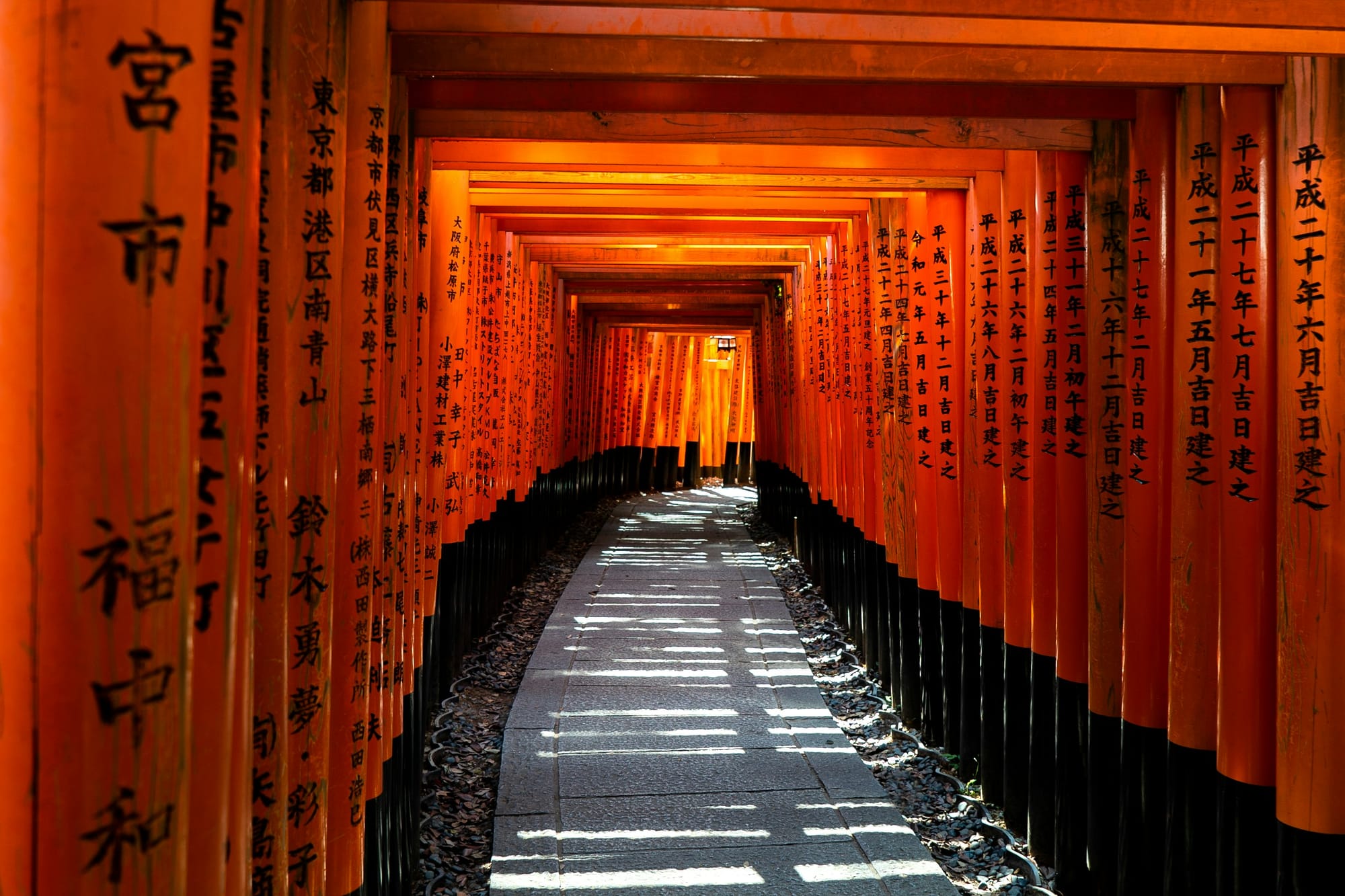

Basic Information on Kyoto and Osaka
Kyoto and Osaka are two major cities representing Japan's Kansai region. Let's look at the basic information of both cities in detail while comparing their characteristics.
History and Culture

Kyoto boasts over 1200 years of history as Japan's ancient capital. Since its establishment as Heian-kyo in 794, it has flourished as the center of Japanese politics and culture.
When I lived in Kyoto, I made new discoveries almost every day. For instance, when I stumbled upon a small temple with hundreds of years of history in a seemingly ordinary alley, I felt that this was truly unique to Kyoto.
Kyoto has numerous World Heritage-listed temples and shrines, such as Kinkaku-ji and Kiyomizu-dera. These structures convey Japan's traditional architectural beauty and spirituality to this day. Many traditional events like the Gion Festival and Jidai Festival also have over a thousand years of history, giving a sense of the depth of Japanese culture.
On the other hand, Osaka, known as the "Nation's Kitchen," developed as a commercial center. During the Edo period, it flourished as the economic center where goods from all over Japan gathered. Even now, it plays an important role as Japan's second-largest economic zone.
Osaka's history is ancient, with Naniwa Palace established during the Asuka period, but it later developed as a commercial city. The landscape where historical structures like Osaka Castle and Shitennoji Temple coexist with modern skyscrapers symbolizes Osaka's history and modernity.
Although these two cities are only about 40 minutes apart by train, their atmospheres are vastly different. While Kyoto has a quiet and calm atmosphere, Osaka gives an impression of a vibrant and lively city.
Geography and Climate
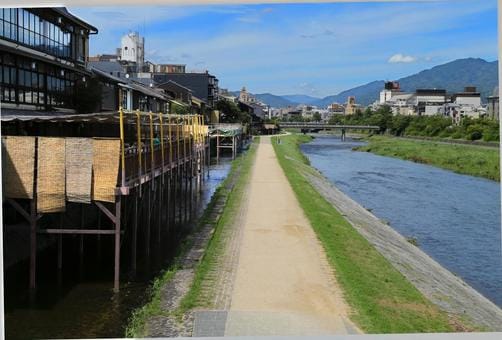
Kyoto and Osaka have different geographical and climatic characteristics. These differences greatly influence the landscape and lifestyle of each city.
Kyoto is located in a basin surrounded by mountains on three sides. Due to this geographical feature, Kyoto becomes extremely hot in summer and cold in winter.
When I lived in Kyoto, I was really surprised by the intensity of the humid heat in summer and the severe cold in winter.
However, this unique climate creates Kyoto's beautiful natural scenery. You can enjoy the beauty of each season: cherry blossoms in spring, fresh green maple leaves in summer, autumn foliage, and snow scenes in winter.
On the other hand, Osaka is located on a plain facing the sea. Compared to Kyoto, temperature changes are milder, making for a more comfortable climate. When I moved to Osaka, I was really helped by this difference in climate. In both summer and winter, you don't feel the extreme heat or cold like in Kyoto.
Osaka is more urbanized, so it can't be said to be rich in nature, but there are green spaces scattered throughout, such as Osaka Castle Park and Expo Commemoration Park.
The beauty of cherry blossoms blooming against the backdrop of skyscrapers, which I often see during my weekend walks in Osaka Castle Park, is a sight unique to Osaka.
While both cities have distinct four seasons in common, how they manifest is different. In Kyoto, you can feel the seasons in nature and historical buildings, while in Osaka, you can sense the changing of seasons within the city.
Who Should Visit Kyoto and Osaka
Kyoto and Osaka are cities that each have different attractions. Whether you should visit Kyoto or Osaka, or both, largely depends on the interests and preferences of the traveler. Let's take a closer look at who each city is recommended for.
Who Should Visit Kyoto
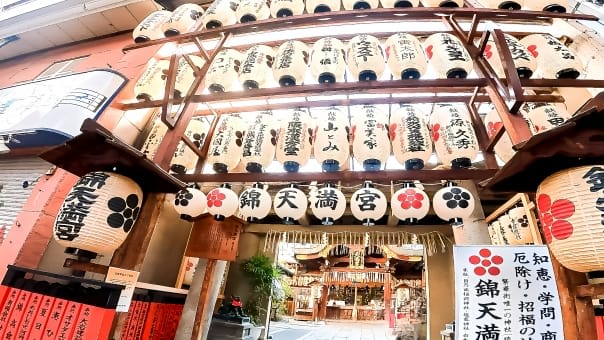
Kyoto is ideal for those interested in traditional Japanese culture and history. As an ancient capital with over 1200 years of history, Kyoto is concentrated with Japanese culture and spirituality.
Kyoto is perfect for those who prefer a quiet and calm atmosphere. Although the number of tourists has increased recently, when you visit Kyoto's temples and gardens, you can find time to reflect on yourself in silence, away from the hustle and bustle.
For those who want to enjoy visiting temples, shrines, and Japanese gardens, Kyoto is a treasure trove. There are numerous World Heritage-listed temples such as Kinkaku-ji, Kiyomizu-dera, and Ryoan-ji, each with its own unique charm.
Those interested in Japanese cuisine or matcha sweets should also visit Kyoto. Kyoto's cuisine, called "Kyoto cuisine," is like a work of art with its delicate flavors and beautiful presentation.
Matcha sweets are also a specialty of Kyoto, and you can enjoy various types from matcha soft-serve ice cream to high-end Japanese sweets.
Kyoto is also ideal for those who want to experience cultural activities such as wearing kimono or participating in tea ceremonies. There are many kimono rental shops in Kyoto, and the experience of strolling through the ancient capital in kimono will be unforgettable.
Tea ceremony experiences are also a good opportunity to deeply understand Japanese traditional culture.
Who Should Visit Osaka
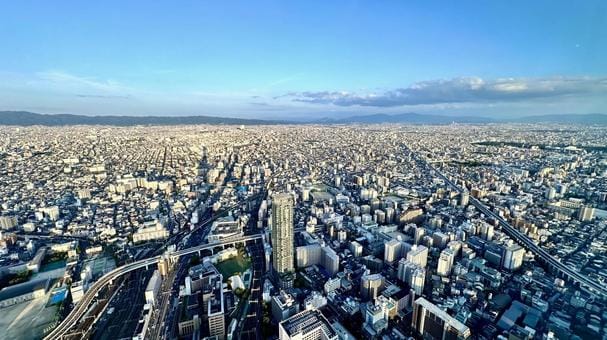
Osaka is the perfect place for those who want to enjoy the vibrant atmosphere of a city. Having lived in Osaka for over 10 years, I feel that the vitality of this city is a source of daily stimulation in my life.
Especially when walking through bustling areas like Dotonbori or Shinsaibashi, you'll be overwhelmed by the hustle and bustle. The neon lights, people's laughter, the aroma of food... everything mixes together to create Osaka's unique vitality.
For those interested in B-class gourmet food and popular food culture, Osaka is like heaven. Osaka's specialty dishes like takoyaki, okonomiyaki, and kushikatsu are popular and delicious despite being affordable.
My personal favorite is the kushikatsu in Shinsekai. The crispy battered exterior with juicy ingredients inside creates an exquisite taste when dipped in sauce.
Osaka is also recommended for those who want to enjoy shopping and modern entertainment. Large shopping malls line up in Shinsaibashi and Umeda, offering a wide range of products from the latest fashion items to electronics.
There are also theme parks like Universal Studios Japan (USJ), providing a wealth of entertainment options.
Osaka is perfect for those who want to experience nightlife and the bustle of downtown areas. The downtown areas of Dotonbori and Shinsaibashi become even more lively at night, and the cityscape illuminated by neon lights is spectacular.
Who Should Visit Both
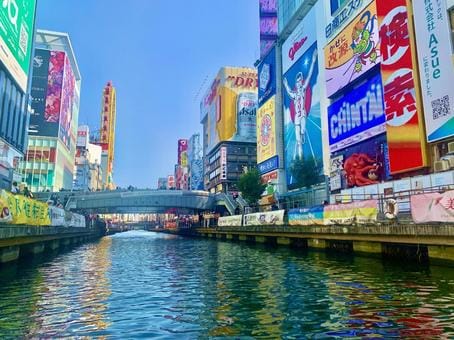
For those who want to experience diverse aspects of Japan, I recommend visiting both Kyoto and Osaka. From my own experience of living in both cities, I believe that visiting both is the best way to fully appreciate their respective charms.
A route that allows you to experience traditional Japanese culture in Kyoto and then modern Japan in Osaka would make for a wonderful trip where you can taste both the history and present of Japan at once.
I especially recommend visiting both cities if you have more than a week to stay. Kyoto and Osaka are about 40 minutes apart by train, making it possible to travel back and forth in a day.
I often used to go back and forth between Kyoto and Osaka on weekends. For example, I would visit temples in Kyoto on Saturday and enjoy shopping and gourmet food in Osaka on Sunday. If you have enough time like this, you can fully enjoy the charms of both cities.
Comparison of Tourist Spots
Kyoto and Osaka each have plenty of tourist spots with their own unique charms. Here, I'll introduce and compare the representative tourist spots of both cities in detail.
Recommended Spots in Kyoto
Kyoto is a treasure trove of tourist spots where you can experience traditional Japanese culture and history. From World Heritage-listed temples and shrines to atmospheric townscapes, there are various attractive spots.
Kinkaku-ji
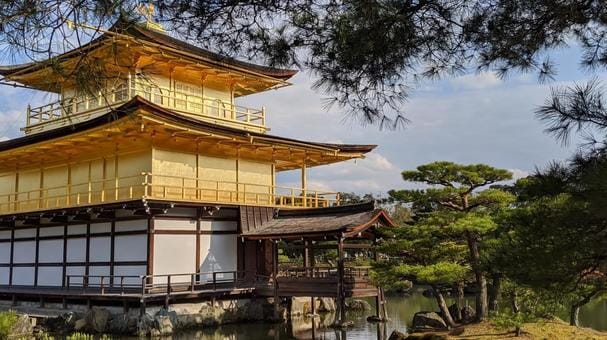
Kinkaku-ji is one of Kyoto's representative tourist spots. Its formal name is Rokuon-ji, but it's called Kinkaku-ji (Golden Pavilion) due to its golden exterior.
The top two floors of the three-story building are covered in gold leaf, and its beauty is overwhelming to behold. Especially if you visit on a sunny afternoon, the sight of the golden pavilion shimmering in the sunlight is breathtakingly beautiful.
The charm of Kinkaku-ji is not just the building. The surrounding Japanese garden is also wonderful, and you can enjoy the scenery of each season. The contrast between the golden building and the trees turning red and yellow is especially spectacular during the autumn foliage season.
Fushimi Inari Taisha
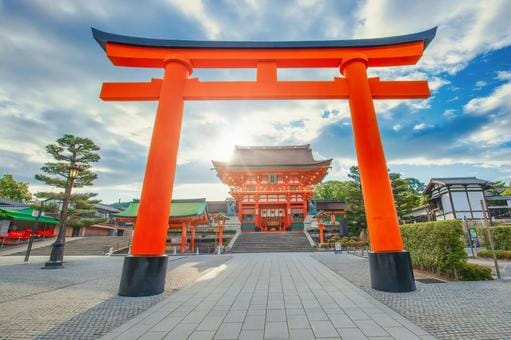
Fushimi Inari Taisha is a shrine famous for its thousands of torii gates. It enshrines the Inari deity known as the god of prosperous business and is the head shrine of about 30,000 Inari shrines across Japan. When I first visited Fushimi Inari Taisha, I was overwhelmed by its scale and the number of torii gates.
The main attraction of Fushimi Inari Taisha is undoubtedly the thousands of torii gates. The tunnel of vermilion torii gates continuing to the top of the mountain gives a strange sensation as if you've wandered into another world. As you walk between the torii gates, you feel like you're in a sacred space cut off from everyday life.
Hiking to the summit is also one of the pleasures. If you climb to the top, which takes about 2 hours, you'll be rewarded with a panoramic view of Kyoto city.
Kiyomizu-dera

Kiyomizu-dera is one of Kyoto's representative tourist spots and is registered as a World Heritage site. When I lived in Kyoto, Kiyomizu-dera was a standard spot for guiding friends and family. Its spectacular views and historical value never fail to impress, no matter how many times I visit.
The most distinctive feature of Kiyomizu-dera is its wooden stage. From the stage, which is 13 meters above the ground, you can overlook Kyoto city.
Especially during the cherry blossom season in spring and the autumn foliage season, the view from the stage is breathtakingly beautiful. I make it a rule to visit Kiyomizu-dera every year during the autumn foliage season, and each time I make new discoveries and never get bored.
The night illumination at Kiyomizu-dera is also beautiful, allowing you to enjoy a fantastical atmosphere different from daytime. The illumination during the special viewing periods in spring and autumn is particularly spectacular, with the stage and surrounding trees floating in the darkness - it's a must-see.
There are also many food stalls around Kiyomizu-dera. The stone-paved slopes called Ninenzaka and Sannenzaka are lined with Japanese confectionery shops and souvenir shops, allowing you to stroll while enjoying the Kyoto-like atmosphere.
My recommendation is to enjoy tea and Japanese sweets at these slopes after visiting Kiyomizu-dera. The moment of having a break while looking at the garden in a café renovated from a traditional townhouse is one of the highlights of Kyoto sightseeing.
Arashiyama
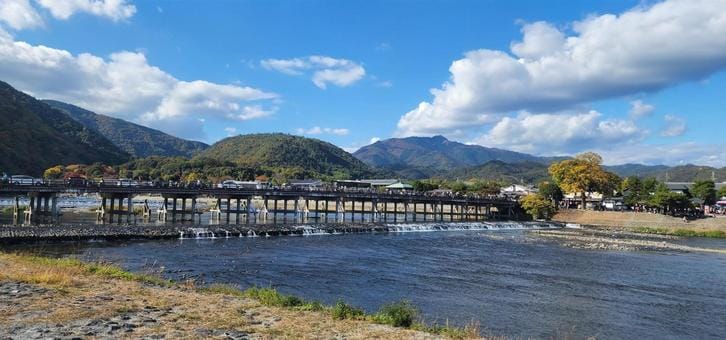
Arashiyama is one of Kyoto's representative scenic spots, and it was my favorite place for weekend strolls when I lived in Kyoto. With its rich natural scenery and various activities to enjoy, Arashiyama is a charming place where you won't get bored even if you spend a whole day there.
Togetsukyo Bridge, which could be called the symbol of Arashiyama, is an elegant bridge over the Katsura River, creating a beautiful scenery in harmony with the mountains in the background.
I especially liked visiting Togetsukyo Bridge during the autumn foliage season. The sight of trees turning red and yellow, with the bridge reflected in the river surface, is like a painting.
One of Arashiyama's charms is its atmospheric bamboo grove. Walking through the bamboo path gives you a sense of entering a world of silence, cut off from the surrounding bustle. The experience of walking while listening to the rustling of bamboo is calming. When I was tired from work, I used to refresh my mind by strolling through this bamboo grove.
Arashiyama is also famous as a spot for autumn foliage. From mid to late November, the sight of the mountains turning red and yellow is spectacular. Especially during the night illumination period, you can enjoy a fantastical atmosphere.
When sightseeing in Arashiyama, I also recommend taking the Sagano Romantic Train. This trolley train that leisurely travels about 7.3 kilometers from Arashiyama to Kameoka, allowing you to enjoy the scenery, is especially popular during the autumn foliage season. The spectacular view of Hozugawa Gorge outside the window will undoubtedly become an unforgettable memory.
Nishiki Market
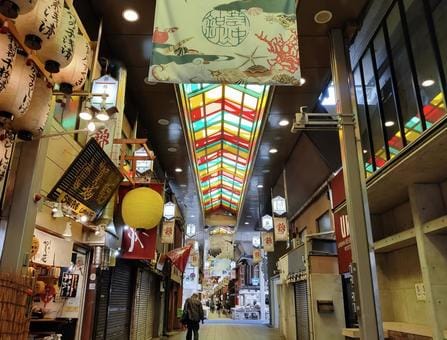
Nishiki Market, called the "Kitchen of Kyoto," is a market with over 400 years of history. Along the approximately 400-meter shopping street, Kyoto's traditional ingredients and specialties are crammed together.
The charm of Nishiki Market is, above all, its abundance of products. All kinds of food ingredients are lined up, including Kyoto's traditional ingredients such as Kyoto vegetables, fresh fish, dried foods, pickles, and Japanese sweets.
Also, the joy of food-hopping in Nishiki Market is exceptional. Everything is delicious, from freshly grilled tamagoyaki (rolled omelet), freshly made yuba (tofu skin), to daifuku (rice cakes) made with seasonal fruits.
Nishiki Market is the best place to experience Kyoto's food culture. However, in recent years, there are many tourists, and it gets especially crowded on weekends.
My recommendation is to visit on a weekday morning. It's relatively less crowded at this time, so you can enjoy the market at a leisurely pace.
Recommended Spots in Osaka
Osaka is a city with diverse tourist spots where modern urban charm coexists with historical sites. Here, I'll introduce some representative tourist spots in Osaka.
Osaka Castle

Osaka Castle is one of Osaka's representative tourist spots. This castle, built by Toyotomi Hideyoshi, symbolizes Osaka's history and culture. When I moved to Osaka over 10 years ago, Osaka Castle was the first place I visited. I still vividly remember being overwhelmed by its majesty.
The charm of Osaka Castle lies in its grand appearance. The 55-meter-tall main tower maintains its presence even while surrounded by modern skyscrapers.
Especially the sight of Osaka Castle illuminated at night is spectacular, creating a beautiful scene in contrast with the modern urban landscape.
The view from the castle tower is also wonderful. From the observation deck on the top floor, you can see a 360-degree view of Osaka city. I always take my friends and family here when they visit Osaka. The view overlooking Osaka's cityscape never fails to impress visitors.
Osaka Castle becomes a famous spot for cherry blossoms in spring. Osaka Castle Park, with about 3,000 cherry trees in full bloom, is crowded with people enjoying hanami (cherry blossom viewing). It has become my annual tradition to go for hanami with my colleagues. The contrast between the full-bloom cherry blossoms and Osaka Castle is truly a spectacular sight.
Dotonbori
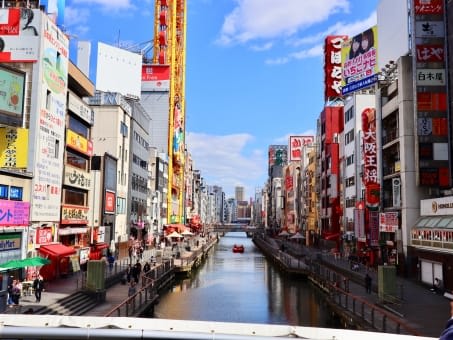
Dotonbori is a popular tourist spot known as Osaka's downtown area. It's a place characterized by neon-lit streetscapes and a vibrant atmosphere, where you can fully enjoy Osaka's charm as a "city of kuidaore" (eat until you drop).
The symbol of Dotonbori could be said to be the giant Glico sign. The moving sign shines even more brightly at night, becoming a photo spot for many tourists. When my friends or family visit Osaka, I always take a commemorative photo in front of this sign.
Dotonbori is also famous as a sacred place for food-hopping Osaka specialties. Shops selling Osaka's specialty dishes like takoyaki, okonomiyaki, and kushikatsu are lined up.
In Dotonbori, you can enjoy not only dining but also shopping. Large electronics stores, cosmetics stores, and fashion brand shops are lined up, making it an irresistible place for shopping enthusiasts. On holidays, I enjoy checking out the latest gadgets or looking for new clothes here.
Tsutenkaku and Shinsekai
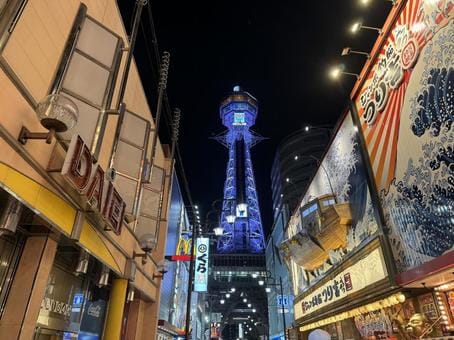
Tsutenkaku and Shinsekai are popular tourist spots that strongly retain the atmosphere of Osaka's downtown.
Tsutenkaku is known as a symbolic presence in Osaka. This 103-meter-tall tower, rebuilt in 1956, is regarded as a symbol of Osaka's reconstruction and development.
I still can't forget the excitement I felt when I first went up Tsutenkaku. From the observation deck, you can see a 360-degree view of Osaka city, and the night view is especially spectacular.
Shinsekai is an area spreading around Tsutenkaku with a retro atmosphere. Here, you can enjoy kushikatsu, known as the taste of Osaka's common people.
The charm of the Tsutenkaku and Shinsekai area lies in its unique vitality and nostalgic atmosphere. The streetscape, where tourists and locals mix, seems to encapsulate the charm of Osaka.
I especially like to visit here on nights when I'm tired from work. The moments of enjoying kushikatsu and beer while chatting with friendly shop owners and regular customers are blissful times.
Universal Studios Japan
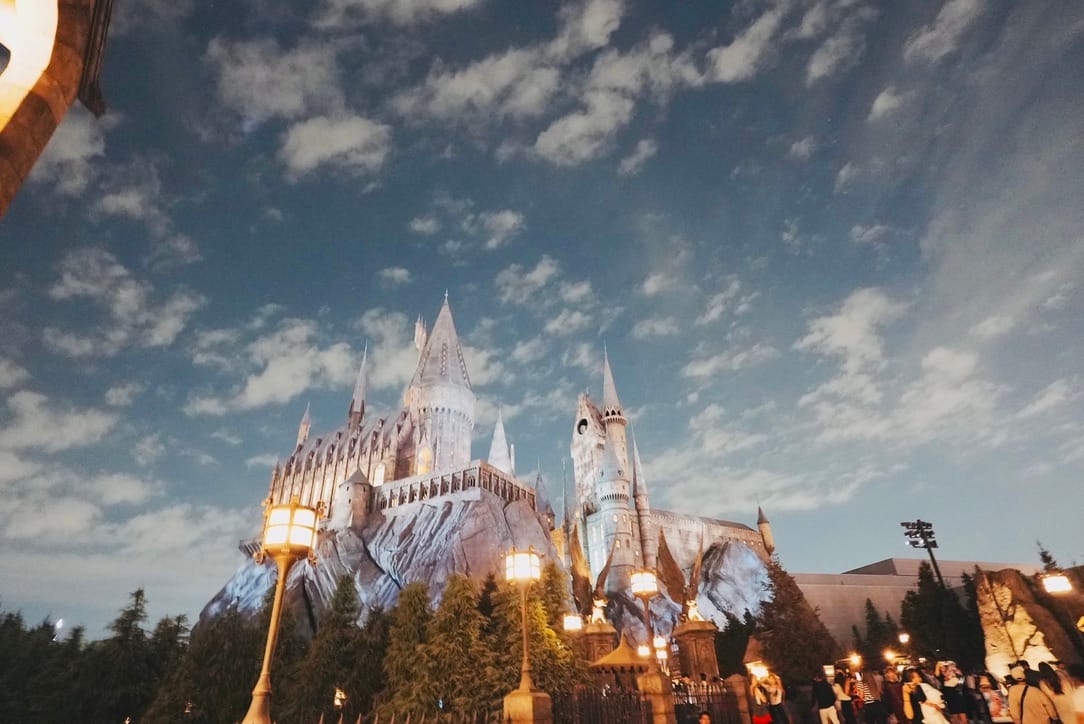
Universal Studios Japan (USJ) is a popular theme park representing Osaka. I've been living in Osaka for over 10 years, and as an annual pass holder, I visit a few times a month - it's one of my favorite places.
The charm of USJ lies in its diverse attractions. There's a wide variety of attractions, from thrilling roller coasters to gentle rides that children can enjoy.
My favorite is "Harry Potter and the Forbidden Journey." The sense of realism, as if you've entered the world of magic, excites me no matter how many times I experience it.
In recent years, Nintendo World has been particularly popular.
Nintendo World is a new area where you can experience the world of Mario. When I first visited this area, I was surprised by its immersiveness. It's a space that both adults and children can enjoy, feeling as if you've entered a game.
Especially the ride themed after Mario Kart is a wonderful attraction that gathers the best of technology. Every time I take my friends there, they express amazement.
Also, USJ offers rich seasonal events. You can enjoy decorations, shows, and limited goods matching the season, such as Halloween and Christmas.
I especially like the Halloween season, and it has become my tradition to visit in costume. The whole park turns into a haunted house-like atmosphere, providing a thrilling experience even for adults.
Abeno Harukas
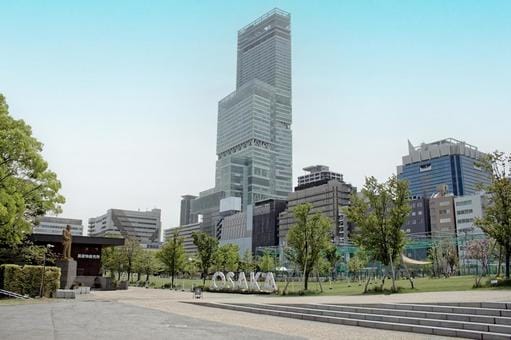
Abeno Harukas, the second tallest building in Japan, is known as Osaka's new landmark. I remember vividly how I was taken aback by its overwhelming height and the view from the top floor when I first visited this building right after it opened.
The greatest charm of Abeno Harukas is undoubtedly the view from the observation deck. From "Harukas 300," the observation deck at a height of 300 meters above ground, you can see a 360-degree view of Osaka city.
There's also an art museum in Abeno Harukas. "Abeno Harukas Art Museum" exhibits excellent artworks from Japan and abroad.
Moreover, Abeno Harukas houses a large-scale shopping mall. Various shops are available, from fashion brands to general stores and restaurants. I often enjoy shopping with friends on holidays.
Abeno Harukas is closely related not only to tourism but also to the daily lives of local people. It includes offices and hospitals, and many people use it daily.
Kuromon Market
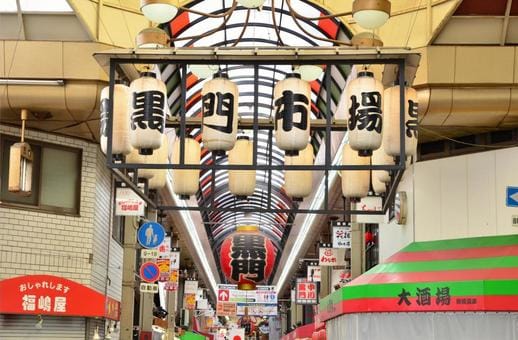
Kuromon Market, called Osaka's kitchen, is a market with over 190 years of history. About 150 shops are lined up along the approximately 580-meter shopping street, making it Osaka's leading food treasury.
When I had just moved to Osaka, a local friend took me here for the first time, and I still vividly remember being overwhelmed by its vitality and diversity.
The greatest charm of Kuromon Market is undoubtedly its array of fresh ingredients. Especially the variety of seafood is spectacular, and you can see various types of fish from seasonal catches to rare marine products.
Also, Kuromon Market is a treasure trove of Osaka's specialty gourmet foods. You can casually enjoy Osaka flavors such as takoyaki, okonomiyaki, and kushikatsu.
Recently, there are increasing numbers of shops offering Japanese foods like sushi and tempura for foreign tourists, creating an internationally colorful atmosphere.
Comparison of Gourmet Food
Kyoto and Osaka are known as cities with their own unique food cultures. By comparing the gourmet foods of both cities, you can understand the depth of Kansai's food culture.
Kyoto's Gourmet Food
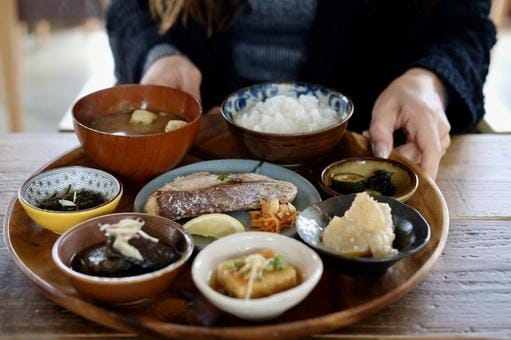
Kyoto's food culture is characterized by refined tastes backed by its long history and tradition.
Kyoto cuisine represents Kyoto's gourmet food. It's characterized by the use of seasonal ingredients and cooking methods that bring out the original taste of the ingredients. What particularly left an impression on me was dining at a long-established ryotei (high-class Japanese restaurant). Each dish was beautifully presented, and the array of dishes that looked like works of art made the meal itself feel like a cultural experience.
Yudofu (boiled tofu) is one of Kyoto's representative dishes and can be considered a representative of shojin ryori (Buddhist vegetarian cuisine). It's a simple yet sophisticated dish that highlights the quality of the tofu and the depth of the dashi broth.
Matcha sweets are also one of Kyoto's representative gourmet foods. You can enjoy various sweets using matcha, from traditional Japanese confections to Western-style desserts.
Obanzai represents Kyoto's home cooking. These simple yet flavorful dishes using seasonal vegetables allow you to experience Kyoto's everyday food culture. When I lived in Kyoto, it was my daily routine to visit the neighborhood obanzai shop.
Osaka's Gourmet Food
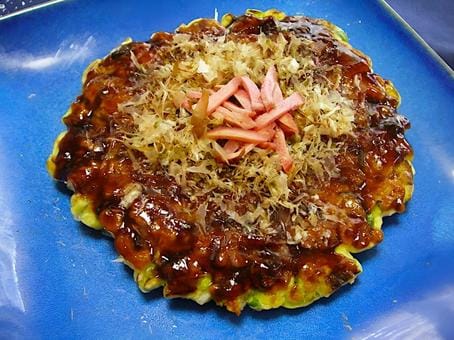
Osaka is called the "city of kuidaore" (eat until you drop), indicating its rich food culture.
Takoyaki is one of Osaka's representative soul foods. The texture of crispy outside and soft inside, along with the taste of the dashi-flavored batter, is exquisite.
Okonomiyaki is also one of Osaka's representative dishes. It's a vegetable-rich dish cooked on an iron plate, and the excitement of cooking it on the spot is part of its charm.
My personal favorite is "butayaki," which uses plenty of cabbage and pork. Waiting for the okonomiyaki to cook on the iron plate while drinking beer at an okonomiyaki shop is, I feel, the essence of Osaka nights.
As symbolized by the word "kuidaore," Osaka's food culture is characterized by affordable and delicious common people's tastes. For example, there are many shops where you can enjoy authentic tastes at reasonable prices, such as standing udon shops or cheap and delicious set meal restaurants.
I often have dinner at these common people's shops on my way home from work, and I'm impressed every time by the good balance of taste and price.
Kushikatsu is also one of Osaka's specialty dishes. Kushikatsu, with its crispy batter and juicy inside, is perfect with beer. Kushikatsu shops in Shinsekai are particularly famous and attract many tourists.
551 Horai's steamed pork buns are known as a standard Osaka souvenir. The combination of juicy meat and fluffy dough is exquisite. I always buy these steamed pork buns as souvenirs for friends and family visiting Osaka. There are also shops inside stations, so I recommend buying them on your way back at the end of your trip.
The characteristic of Osaka's gourmet food lies in the balance between its approachability and good taste. You can eat really delicious food even at inexpensive places. That's what I consider to be the charm of Osaka's food culture.
Comparison of Shopping
Kyoto and Osaka are cities with their own distinctive shopping spots. Shopping experiences in both cities provide wonderful opportunities to feel Japan's tradition and modernity simultaneously.
Shopping in Kyoto
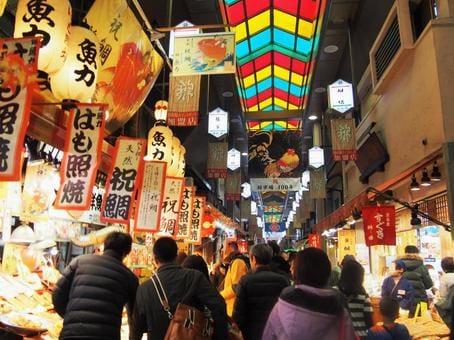
Shopping in Kyoto is deeply connected to Japanese traditional culture.
The biggest charm of Kyoto is the abundance of Japanese sundries and traditional craft souvenirs. For example, many shops selling traditional crafts such as Kyoto fans, Kyoto dolls, and Kiyomizu pottery are lined up around Kiyomizuzaka and Gion.
You can also enjoy shopping for kimono and Japanese accessories in Kyoto. There are many shops dealing with modern designed kimono and Japanese accessories on Shinkyogoku Street and Shijo Street, which are also popular among young generations.
Japanese sweets and tea leaves are popular as Kyoto souvenirs. In Japanese confectionery shops, you'll be captivated by the beauty of freshly made sweets. These shopping experiences feel more like a part of experiencing Kyoto's culture rather than just shopping.
In Kyoto, you can also find unique products that fuse tradition and modernity. For example, smartphone cases with maiko motifs or modern bags using Kyo-yuzen dyeing techniques are popular products that modernly arrange traditional craft techniques.
The charm of shopping in Kyoto lies in the fact that you can not only purchase items but also experience Kyoto's culture, history, and craftsmanship in the process.
Shopping in Osaka

Shopping in Osaka is characterized by its diversity and vitality.
The center of shopping in Osaka is the Shinsaibashi and Namba areas. Large commercial facilities are lined up in this area, dealing with a wide range of products from famous domestic and international brands to local fashion brands.
My favorite is the Shinsaibashi-suji Shopping Street. Various shops selling fashion, general goods, and food are lined up along this arcade street that continues for about 600 meters. When I walk here on holidays, I'm overwhelmed by its energy and bustle. Humorous Osaka-style souvenirs are also popular.
For shopping for electrical appliances, I recommend Nipponbashi's Denden Town. Various large and small electrical shops are gathered here, and you can find all kinds of electrical products from the latest gadgets to rare electronic components.
Osaka's underground shopping malls are also attractive shopping spots. Especially the underground mall in Umeda is famous for its large scale and complexity. I got lost when I first visited, but now it has become an important meeting place. The big attraction is that you can shop comfortably even on rainy days.
Comparison of Transportation Access
Kyoto and Osaka each have characteristic transportation systems. By comparing the transportation access of both cities, travelers can enjoy sightseeing more efficiently.
Transportation in Kyoto

Kyoto's transportation system is designed to harmonize with its historical streetscape. The main means of transportation are city buses, subways, and bicycles.
City buses are the main means of transportation for sightseeing in Kyoto. When I lived in Kyoto, city buses were an indispensable part of daily life.
Bus routes cover the main tourist spots in the city, making it easy to access famous places like Kinkaku-ji and Kiyomizu-dera. However, it gets very crowded during tourist seasons, so I recommend allowing extra time when traveling.
The subway has two lines: the Karasuma Line running north-south and the Tozai Line running east-west. Compared to city buses, subways run more frequently and on time, so I recommend them when you're concerned about time.
Rental bicycles are also an essential means of transportation for sightseeing in Kyoto. Kyoto has relatively flat terrain, making it suitable for cycling. I also enjoyed exploring Kyoto by bicycle on holidays. Especially, the cycling road along the Kamo River is atmospheric, and cycling while feeling the changing seasons is exceptional.
However, it takes some getting used to Kyoto's transportation system. City buses, in particular, have complex routes and can be confusing for first-timers. I recommend researching the bus stops and routes to your destinations in advance.
Transportation in Osaka

Osaka's transportation system is highly developed, reflecting the city's scale and modernity. The main means of transportation are subways, JR lines, private railways, and buses.
The subway has a complex network of lines covering Osaka city. When I first moved to Osaka, I was confused by this complex route map, but now it's an indispensable part of daily life. The Midosuji Line is particularly convenient.
This line runs north-south through Osaka, connecting major downtown areas like Umeda, Shinsaibashi, and Namba. I recommend tourists remember this line. Also, subways run frequently, so you can move efficiently with little waiting time.
The JR Osaka Loop Line is a line that circles the center of Osaka city, convenient for accessing major spots. I often use this line to visit tourist spots like Osaka Castle, Tennoji, and Shinsekai.
It takes about an hour to make a full circle on the Loop Line, so it's also enjoyable to move while viewing the cityscape of Osaka. Especially for first-time visitors to Osaka, I recommend riding this Loop Line to get a feel for the atmosphere of Osaka.
Buses mainly play a role in complementing subways and JR lines.
Kyoto and Osaka each have unique characteristics in their transportation systems. Kyoto's transportation system harmonizes with its historical streetscape, while Osaka has a modern and efficient transportation network. I think you can experience the diversity of Japanese transportation systems by visiting both cities.
Frequently Asked Questions about Kyoto and Osaka
When visiting Kyoto and Osaka, many travelers have similar questions. Here, I'll answer common questions based on my experience and observations.
Which is More Popular Among Foreign Tourists, Kyoto or Osaka?

Both Kyoto and Osaka are very popular cities among foreign tourists. However, the reasons for their popularity are slightly different.
In my opinion, people interested in traditional Japanese culture and history tend to prefer Kyoto. Kyoto has famous temples and shrines like Kinkaku-ji and Kiyomizu-dera, where you can enjoy traditional Japanese beauty.
There are also many opportunities to experience traditional Japanese arts like maiko and geiko. When I lived in Kyoto, I often saw foreign tourists walking around town wearing kimono.
On the other hand, people who want to experience modern Japan tend to choose Osaka. Osaka has attractions like Universal Studios Japan and the huge Osaka Aquarium Kaiyukan, where you can enjoy entertainment.
Also, in bustling areas like Dotonbori and Shinsaibashi, you can enjoy neon-lit night views and the lively atmosphere of the city. Living in Osaka, I notice that foreign tourists seem to be fascinated by the brightness and friendliness of Osaka's people.
In reality, most tourists visit both cities. Kyoto and Osaka are only about 30 minutes apart by train, and many tourists combine these two cities in their travel plans.
When I guide friends from overseas, I always make sure to visit both cities. Experiencing traditional culture in Kyoto and then feeling the energy of modern Japan in Osaka. I believe this contrast is very effective in understanding the diversity of Japan as a country.
Osaka has the advantage of having Kansai International Airport, making it easily accessible from overseas. Many tourists enter Japan through Osaka and then head to Kyoto.
I often use Kansai International Airport when returning from overseas trips, and each time I see many foreign tourists with excited looks on their faces.
Which is More Expensive, Kyoto or Osaka?

Comparing the prices in Kyoto and Osaka, Kyoto tends to be more expensive in general. This is something I strongly felt from my experience of living in both cities.
Accommodation facilities, in particular, are more expensive in Kyoto. Kyoto is very popular as a tourist destination, and accommodation prices soar especially during cherry blossom season and autumn foliage season.
I remember struggling to find accommodation for visiting friends and family when I lived in Kyoto. On the other hand, Osaka has more options like business hotels, and you can find relatively reasonably priced accommodations.
Regarding restaurants, I have the impression that Osaka has more reasonably priced places. As Osaka is called the "city of kuidaore" (eat until you drop), there are many restaurants that offer delicious meals at affordable prices.
On the other hand, while Kyoto has a wide range of restaurants from high-class ryotei to common places, the overall price range tends to be higher. Especially, restaurants near tourist spots tend to be more expensive.
Regarding souvenirs, I feel that Kyoto has more high-end oriented products. Kyoto's traditional crafts and high-grade Japanese sweets are priced higher due to their high quality. The hand-made fan I bought in Kyoto impressed me with its beauty and craftsmanship, but the price was correspondingly high.
Osaka souvenirs tend to be more common and affordable. For example, there are many unique and affordable souvenirs like takoyaki-flavored snacks.
Transportation costs are about the same in both cities. However, as tourist spots are scattered around Kyoto, you might end up spending more on transportation. In Osaka, due to its relatively compact urban structure, you can efficiently visit major tourist spots by subway.
Overall, while Kyoto is more expensive, you often get unique experiences and high-quality services in return. On the other hand, Osaka is more common and you can enjoy various experiences at reasonable prices.
In Which City Can You Feel More "Japanese-ness", Kyoto or Osaka?

When comparing Kyoto and Osaka from the perspective of "Japanese-ness", each city embodies different aspects of Japan's characteristics.
If you want to feel traditional Japanese-ness, Kyoto is undoubtedly recommended. Kyoto is an ancient capital with over 1200 years of history, where traditional Japanese culture remains strong. Also, Kyoto offers abundant opportunities to experience traditional Japanese cultural activities like tea ceremony and flower arrangement.
On the other hand, if you want to feel modern Japanese-ness, Osaka is recommended. As Japan's second-largest metropolis, Osaka embodies the vitality and energy of modern Japan. For example, places like neon-lit Dotonbori or Universal Studios Japan with its cutting-edge technology are places where you can feel modern Japan's pop culture and technology.
Also, Osaka's food culture is one of the symbols of modern Japan. Osaka's specialty dishes like takoyaki and okonomiyaki represent Japanese popular culture.
Kyoto is rich in historical buildings and cultural experiences, allowing you to strongly feel Japan's traditional beauty and spirituality. On the other hand, Osaka has many modern buildings and entertainment facilities, allowing you to experience the vitality and popular culture of modern Japan.
I recommend visitors to visit both cities if possible. Experience Japanese traditions in Kyoto and feel the energy of modern Japan in Osaka. Experiencing this contrast should lead to a deeper understanding of Japan.
Which is More Suitable for Family Trips with Children, Kyoto or Osaka?

When choosing a city suitable for family trips with children, the judgment may differ depending on the purpose and the age of the children, but overall, I would say Osaka is more suitable for family trips with children. I've come to this conclusion from my own experience of taking my nieces and nephews to both cities.
Osaka has many facilities for children. The most popular is undoubtedly Universal Studios Japan (USJ).
I can't forget the sparkle in my 6-year-old nephew's eyes when I took him to USJ. It's packed with elements that children can be enthusiastic about, from the world of Harry Potter to Minion rides.
There's also Kaiyukan, one of the world's largest aquariums. The surprised expressions on children's faces when they see giant whale sharks up close will surely become lifelong memories.
Moreover, there are many spots where children can enjoy themselves, such as playground equipment in Osaka Castle Park and the zoo adjacent to Tennoji Park. Living in Osaka, I feel that these facilities are scattered throughout the city, making it possible to visit them efficiently.
On the other hand, Kyoto has many quiet temples, which might bore children. When I took my 7-year-old niece to Kyoto, she was initially interested in the sight of maiko in kimono, but she quickly got bored with the continuous temple visits.
However, Kyoto also has spots where children can enjoy themselves. For example, at Toei Kyoto Studio Park, you can experience the world of period dramas. When I visited, children were fascinated by the ninja show. Also, at Arashiyama Monkey Park, you can interact with wild monkeys.
In terms of food, Osaka has more child-friendly menus. Foods that can be eaten by hand, like takoyaki and okonomiyaki, are popular with children.
When I took my nieces and nephews to Osaka, what they especially enjoyed was the experience of grilling their own okonomiyaki. Also, many common eateries in Osaka have rich children's menus, allowing parents to enjoy their meals with peace of mind.
On the other hand, Kyoto's cuisine is generally served in high-class, quiet atmosphere restaurants, which might make dining with children a bit tense.
In terms of transportation, Osaka is more convenient for families with children. Although Osaka's subway network is complex, it provides good access to major tourist spots with short travel times.
On the other hand, in Kyoto, city buses are the main means of transportation, but it can take time to board during crowded times. From my experience of touring both cities with children, I felt that there was less stress from moving around in Osaka.
In conclusion, I would say that Osaka is overall more suitable for family trips with children. It has a well-prepared environment for families with children in various aspects, including the abundance of entertainment facilities, the variety of child-friendly food options, and the convenience of transportation.
My advice is to carefully consider the age and interests of your children, as well as the overall purpose of your family trip, before deciding which city to visit or whether to visit both.
Kyoto and Osaka, as the two major cities representing the Kansai region, each have their own unique charms.
Kyoto, as an ancient capital with over 1200 years of history, vividly retains Japan's traditional culture and aesthetics.
On the other hand, Osaka has developed as a commercial center, embodying the energy and vitality of modern Japan.
We've compared both cities from various perspectives, including tourist spots, gourmet food, shopping, and transportation access. The characteristics of each city are sometimes contrasting and sometimes complementary.
Please visit both cities to feel the diversity of Japan and the Kansai region!




